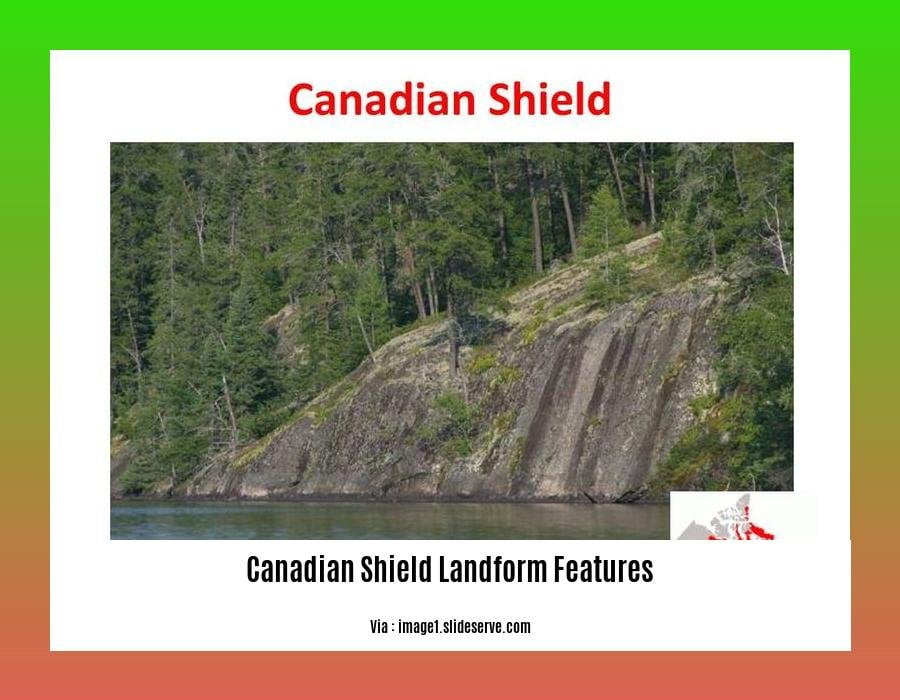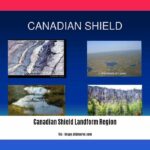The Canadian Shield, home to a plethora of mesmerizing geological wonders, holds within its ancient landscape a treasure trove of fascinating features. In this article, we embark on a journey of discovery, delving into the extraordinary landform characteristics that define the Canadian Shield. From its unique rock formations to its intricate geological processes, we uncover the remarkable secrets and unveil the awe-inspiring natural wonders that make the Canadian Shield a truly remarkable site.
Key Takeaways:
- The Canadian Shield is one of the world’s largest geologic shields, covering approximately 8 million square kilometers.
- It is shaped like a “V” with Hudson Bay in the center and is characterized by thousands of small lakes, thin soil, and rolling hills.
- The lakes in the Canadian Shield were formed through glacial erosion during the last ice age, leaving behind striations and drumlins as evidence of past glacial structures.
- The shield supports a rich variety of vegetation and wildlife, including forests with coniferous trees and species such as moose, black bears, and beavers.
- The Canadian Shield is a valuable source of natural resources, particularly minerals like gold, nickel, and iron ore, as well as lumber from its forests.
- The formation of the Canadian Shield dates back over a billion years ago to the Precambrian era, composed of exposed igneous and metamorphic rocks shaped by glacial erosion and uplift.
- The Canadian Shield not only showcases the geological history of North America but also plays a significant role in the region’s economy and biodiversity.
Canadian Shield Landform Features

The Canadian Shield is a vast and remarkable landform that holds many interesting features and geological wonders. Let’s delve into the distinctive characteristics that define this ancient shield and understand its geological significance.
Shaped by Glacial Forces
The Canadian Shield bears the marks of its icy past. During the last ice age, glaciers swept across the region, leaving behind a unique landscape. One cannot help but be captivated by the thousands of small lakes that dot the shield’s surface, a result of glacial erosion. These lakes add to the shield’s charm and contribute to its overall beauty.
The evidence of past glacial structures is also present throughout the Canadian Shield. Striations, which are lines scraped into rocks, serve as a reminder of the tremendous force exerted by glaciers. Drumlins, long hills made of glacial sediment, further illustrate the powerful impact of these icy giants.
Rich Biodiversity and Vegetation
Despite its thin layer of soil, the Canadian Shield supports a rich variety of vegetation. The shield’s forests are primarily composed of coniferous trees such as spruce and pine. These resilient species have adapted to thrive in the shield’s unique environment.
Moreover, the Canadian Shield is home to diverse wildlife. Moose, black bears, and beavers are just a few of the many animal species that call this landform their home. The shield’s rich biodiversity adds to its allure and showcases the intricate balance of nature within its boundaries.
Abundance of Natural Resources
The Canadian Shield is also known for its abundance of valuable natural resources. Minerals like gold, nickel, and iron ore can be found within its rocky depths, contributing to Canada’s mining industry. Additionally, the shield boasts ample lumber resources, which have played a pivotal role in the region’s forestry industry. The extraction and utilization of these resources have shaped the economy of the Canadian Shield region.
Geological History and Significance
To truly appreciate the Canadian Shield, we must delve into its geological history. This landform was formed over a billion years ago during the Precambrian era. It is composed of exposed Precambrian igneous and high-grade metamorphic rocks that were uncovered through glacial erosion and subsequent uplift.
The Canadian Shield showcases the geologic history of North America, providing valuable insights into the Earth’s ancient past. Its formation and composition provide geologists with a treasure trove of knowledge, allowing them to unravel the mysteries of our planet’s early stages.
Unlocking the Secrets of the Canadian Shield
Exploring the Canadian Shield is an awe-inspiring journey into the geological wonders of North America. From its glacially-formed lakes and distinctive features to its rich biodiversity and abundant natural resources, the shield offers a captivating glimpse into the Earth’s history.
By unraveling the mysteries of the Canadian Shield’s landform features, we gain a deeper understanding of the geological processes that have shaped our world. The shield stands as a testament to the power and beauty of nature, and through our exploration, we can unlock its secrets and continue to appreciate its significance for generations to come.
Canada is home to many incredible non-government organizations. Discover some of them and how they contribute to society by exploring our list of Canadian non-government organizations^Canadian non-government organizations.
The Canadian Shield is a fascinating region that showcases various human activities and their impact. Learn more about the interactions between humans and this unique landform region^Canadian shield human activities.
The Canadian Shield is not only rich in human activities, but also in stunning landforms. Dive deeper into this captivating landform region and discover its geological secrets^Canadian shield landform region.
3. Distinctive Landforms and Topographical Features of the Canadian Shield

When it comes to exploring the wonders of the Canadian Shield, few things can rival its distinctive landforms and topographical features. This vast geologic continental shield stretches across eastern, central, and northwestern Canada, covering a staggering 8 million square kilometers. From glacial lakes to ancient rocks, the Canadian Shield holds a treasure trove of natural marvels waiting to be discovered.
Glacial Erosion and Small Lakes
The Canadian Shield bears the hallmark of its glacial past, as evidenced by the thousands of small lakes scattered across its landscape. These lakes were formed through the process of glacial erosion during the last ice age. As the glacial ice advanced, it shaped the land beneath it, carving out depressions and hollows that eventually filled with water. Today, these small lakes create a picturesque mosaic across the Shield, reflecting the beauty and power of nature.
Rolling Hills and Ancient Structures
As you traverse the Canadian Shield, you’ll encounter rolling hills that undulate as far as the eye can see. These hills bear witness to the ancient glacial structures that shaped the land. Striations, which are lines scraped into rocks, provide a visual record of the immense force exerted by the moving glaciers. Drumlins, long hills of glacial sediment, offer a glimpse into the dramatic transformations that occurred thousands of years ago. These unique landforms are a testament to the Shield’s enduring geological history.
Crystalline Precambrian Rocks
At the heart of the Canadian Shield lies its geological composition, composed primarily of crystalline Precambrian rocks. These rocks hold significant scientific value, as they provide insights into our planet’s ancient past. Exposed over a billion years ago during the Precambrian era, these rocks offer a geological time capsule that researchers eagerly explore. Their presence in the Shield enables us to unravel the mysteries of our planet’s formation and understand the processes that have shaped our world.
Unique Vegetation and Diverse Wildlife
The Canadian Shield boasts a unique blend of vegetation that distinguishes it from other regions of Canada. Across its expanse, you’ll find a mix of deciduous and coniferous trees, creating a lush and diverse forest. As you venture further north, tundra vegetation takes hold, adding an element of wildness to the landscape. This varied vegetation supports a rich assortment of wildlife. Moose roam freely, black bears seek refuge, and beavers construct their homes in the Shield’s abundant lakes and streams. Countless bird species also find solace in this ecologically diverse region.
Contributions to Human History and Natural Resources
The Canadian Shield has played a significant role in human history for thousands of years. Indigenous peoples have inhabited this landform region, harnessing its natural resources for their livelihoods. Minerals such as gold, nickel, and copper have been extracted from the Shield’s depths, contributing to Canada’s economy and industry. Timber harvested from its forests has shaped communities, while freshwater resources have sustained both humans and ecosystems. The Canadian Shield continues to serve as a vital resource, supporting livelihoods and connecting the past with the present.
Key Takeaways:
- The Canadian Shield showcases distinctive landforms shaped by glacial erosion, including small lakes, striations, and drumlins.
- Its geological composition consists of ancient Precambrian rocks, providing valuable insights into Earth’s history.
- The Shield is characterized by a unique blend of vegetation, ranging from deciduous and coniferous trees to tundra in the north.
- Diverse wildlife thrives in this region, with species such as moose, black bears, beavers, and numerous bird species calling the Shield home.
- The Canadian Shield’s natural resources, including minerals, timber, and freshwater, have played a crucial role in human history and continue to support various industries.
Sources:
4. Geological Processes and Formations that Shaped the Canadian Shield
The Canadian Shield, one of the world’s largest geologic continental shields, is a marvel that showcases the fascinating geological processes and formations that have shaped this ancient landform [^1^]. Let’s delve into the remarkable features of the Canadian Shield and explore the forces that have influenced its formation.
Unveiling the Canadian Shield’s Unique Physical Features
The Canadian Shield presents a diverse range of physical features that tell the story of its formation. One of its defining characteristics is the presence of thousands of small lakes, which were carved out through glacial erosion during the last ice age. Delicate layers of soil cover the Shield, and rolling hills grace its landscape, marked by remnants of previous glaciation like striations and drumlins [^2^].
A Geological Journey Through Time
The formation of the Canadian Shield dates back over 3 billion years, shaped by a variety of geological processes. Plate tectonics played a pivotal role, involving the movement and collision of the Earth’s crust. When these crustal plates collided, they melded together, forming larger landmasses. Through plate tectonics, the Canadian Shield evolved and expanded over time [^1^].
The Canadian Shield predominantly consists of metamorphic rocks, testaments to the intense heat and pressure that have shaped this landform. These rocks have undergone profound transformations, with highly deformed and metamorphosed layers resulting from orogeny during the mid- to late Mesoproterozoic era [^2^].
Embracing the Geological Riches of the Canadian Shield
The Canadian Shield’s geological composition presents a treasure trove of natural resources. Metallic minerals like gold, lead, nickel, copper, and zinc are found throughout the Shield, providing valuable resources for various industries. The Shield’s crystalline Precambrian rocks hold great significance in understanding the Earth’s ancient past and the processes that have shaped our world [^2^].
Captivating Flora and Fauna
The Canadian Shield’s unique geology gives rise to diverse ecosystems, supporting exquisite vegetation and abundant wildlife. The shield is predominantly covered by deciduous and coniferous trees, along with tundra in the northern regions. In this captivating landscape, moose, black bears, beavers, and numerous bird species thrive, forming a rich tapestry of biodiversity [^2^].
Key Takeaways:
- The Canadian Shield is a vast geologic continental shield, spanning millions of square kilometers in Canada.
- It is characterized by physical features such as small lakes, thin layers of soil, and rolling hills, all shaped by glacial erosion.
- The Shield was formed through processes like plate tectonics and experienced orogeny in the Mesoproterozoic era.
- It primarily consists of metamorphic rocks and is rich in valuable metallic minerals.
- The Canadian Shield supports a diverse range of vegetation and wildlife, providing unique ecosystems.
- Its geological composition offers valuable insights into Earth’s ancient history and the forces that have shaped the planet.
Sources:
[^1^]: The Canadian Encyclopedia. (n.d.). Canadian Shield. Retrieved from
[^2^]: Britannica. (n.d.). Canadian Shield | Definition, Location, Map, Landforms, & Facts. Retrieved from
5. Significance and Ecological Importance of the Canadian Shield
The Canadian Shield, one of the world’s largest geologic continental shields, holds immense significance and ecological importance. Let’s delve into the reasons why this ancient landform is so fascinating and essential to our understanding of Earth’s history and ecosystems.
Physical Features and Landforms:
– A Landscape Shaped by Ice: Glacial forces during the last ice age sculpted the Canadian Shield, leaving behind distinctive features such as small lakes, striations, and drumlins. These geological formations offer a glimpse into the powerful forces that shaped our planet’s surface.
Formation and Geological Composition:
– Ancient Origins: The Canadian Shield formed over 3 billion years ago through processes like plate tectonics, erosion, and glaciation. Its geological history dates back to the Precambrian era, composed of exposed Precambrian igneous and high-grade metamorphic rocks. Exploring the Shield helps us unravel the Earth’s ancient past and understand the geological processes that have shaped our world.
Vegetation and Wildlife:
– A Rich Boreal Forest: The Canadian Shield is home to the boreal forest, a dominant ecosystem composed of various coniferous trees like white and black spruce. This forest acts as a habitat for numerous plant and animal species, supporting the delicate balance of the Shield’s ecosystem.
– Diverse Wildlife: From the southern regions of the Shield, diverse fish species such as trout, burbot, and northern pike inhabit the lakes and rivers. The Shield also provides a home to other animals like moose, black bears, and beavers, which rely on its unique ecosystem for survival.
Human History and Natural Resources:
– A Land of Indigenous Peoples: The Canadian Shield has a rich history of human habitation by Indigenous peoples for thousands of years. These communities have relied on the Shield’s abundant natural resources, including valuable minerals like gold, nickel, and iron ore. The Shield continues to be an important resource for various industries in Canada.
– Preserving Indigenous Cultures: By acknowledging the significance of the Canadian Shield, we not only appreciate its geological wonders but also recognize the vital cultural heritage of the Indigenous peoples who have lived on this land for generations.
Key Takeaways:
– The Canadian Shield formed over 3 billion years ago through processes like plate tectonics and glaciation.
– Its physical features include small lakes, striations, and drumlins, shaped by ancient ice forces.
– The Shield’s geological composition consists of Precambrian igneous and high-grade metamorphic rocks.
– The boreal forest dominates the Shield’s vegetation, supporting diverse plant and animal species.
– Indigenous peoples have a deep connection to the Shield and have relied on its resources for thousands of years.
Sources:
1. The Canadian Encyclopedia. (n.d.). Canadian Shield
2. Britannica. (n.d.). Canadian Shield | Definition, Location, Map, Landforms, & Facts
FAQ
Q1: What are the physical features of the Canadian Shield?
A1: The Canadian Shield is characterized by thousands of small lakes, thin layers of soil, and rolling hills. These features were primarily formed through glacial erosion during the last ice age.
Q2: What is the geological composition of the Canadian Shield?
A2: The Canadian Shield is predominantly composed of crystalline Precambrian rocks, including sedimentary, igneous, and metamorphic rocks. It also contains valuable metallic minerals such as gold, lead, nickel, copper, and zinc.
Q3: What is the formation history of the Canadian Shield?
A3: The Canadian Shield formed over 3 billion years ago through processes such as plate tectonics, erosion, and glaciation. Plate tectonics refers to the movement and collision of tectonic plates, which contributed to the Shield’s formation.
Q4: What is the dominant vegetation in the Canadian Shield?
A4: The dominant vegetation in the Canadian Shield is the boreal forest, which consists of coniferous trees such as white and black spruce, jack, and red pine. These trees play a vital role in the Shield’s ecosystem.
Q5: What wildlife can be found in the Canadian Shield?
A5: The Canadian Shield is home to diverse wildlife. Fish species such as trout, burbot, and northern pike inhabit the lakes and rivers. Additionally, various animals, including moose, black bears, and beavers, rely on the Shield’s unique ecosystem for survival.
- Unveiling Bernhard Caesar Einstein’s Scientific Achievements: A Legacy in Engineering - July 15, 2025
- Uncover who is Jerry McSorley: CEO, Family Man, Business Success Story - July 15, 2025
- Discover Bernhard Caesar Einstein’s Scientific Contributions: Unveiling a Legacy Beyond Einstein - July 15, 2025















